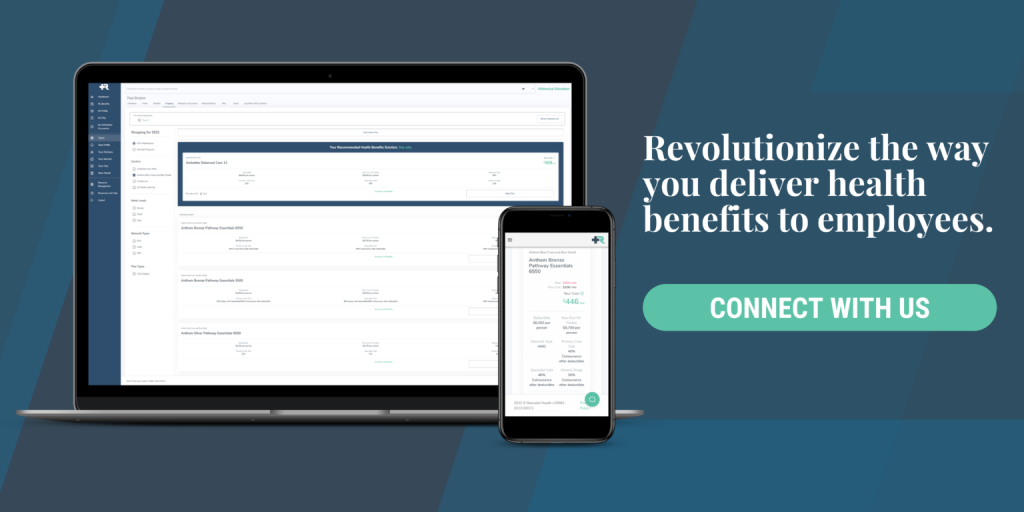Individual Coverage HRAs (ICHRA) became available in 2020 and offer employers the ability to offer healthcare budgets instead of plans. This is beneficial for both employers and their employees, since an ICHRA allows individuals to choose their own healthcare plans.
The Department of Labor projects that nearly 1 million employers will ditch the tradition group plans and begin using this innovative solution for health benefits. But who can use an ICHRA? Does it work for everyone, or only for specific types of organizations and budgets?
The following is a simple breakdown of who can use an ICHRA and how they can be implemented in workplaces.
1. First Time for Health Benefits
Many employers want to offer some sort of health benefit to their team, but they haven’t had the budget to do so. This is often due to a common requirement on traditional group plans which states employers have to have at least 50% participation on the plan and pay at least 50% of the Employee Only coverage.
One issue that often arises in these situations is that of “spousal carve out”. This simply means employees who are happily on a spouse’s health insurance plan end up losing that coverage because they are offered a plan through their employer. However, with an Individual Coverage HRA, that employee can stay on their spouse’s plan, since ICHRA is not classified as a traditional group plan offering.
Qualified Small Employer HRAs (or QSEHRA, pronounced “cue-sara”) tried to help with these types of problems, but their strict guidelines limited their effectiveness. For example, the number of employees an employer could have, the amount of allowance that could be provided, and who actually qualified for advanced premium tax credits were all extremely limited under QSEHRA.
Individual Coverage HRAs, on the other hand, work for employers of any size, allow very flexible allowance amounts, and don’t disqualify employees from tax credits. These things make ICHRA a great fit for employers that are looking to provide health benefits for the first time.
2. Leaving Traditional Group Plans
On average, costs for traditional group plans increase by 5-7% annually. Even worse, double-digit increases have become commonplace for employer sponsored health coverage. This has caused budget control to become the top priority for organizations leaders when choosing health benefits.
Individual Coverage HRAs move away from the product-focused space and toward a budget-focused model for employee health benefits. Instead of choosing just 1 or 2 options for the team, the employer can fix their budget by providing custom allowances to the employees instead. Employees then take that allowance and use it toward a healthcare plan of choice.
This model allows employers to help their teams with healthcare while gaining more precise budget control. Furthermore, it increases employees’ choices often to 30+ plan options. Because of this, leaving traditional group plans for ICHRA has become very attractive for business owners, primarily amongst small to mid-sized organizations.
One thing worth noting about ICHRA is that it can limit an employee’s ability to leverage advanced premium tax credits, which serve as discounts on the cost of individual insurance products. You cannot use pre-tax ICHRA dollars and tax credit discounts. However, Remodel Health’s exclusive ICHRA+™ model allows employers to offer both pre-tax ICHRA dollars, as well as post-tax wage increases. This allows the employee to choose between ICHRA dollars or tax credit discounts, depending on their personal preferences.
In some scenarios, tax credits are even more valuable to the employee than the ICHRA allowance. This makes ICHRA+™ the ideal choice for employers who are moving away from a traditional approach to their health benefits.

3. Applicable Large Employers (ALE)
One of the most exciting attributes of Individual Coverage HRAs is its ability to work for organizations of any size, including Applicable Large Employers (ALE’s) (i.e. organizations with 50+ employees).
If you are an organization leader within an ALE, then you’re likely familiar with the mandate which states you must participate in your employees’ healthcare. However, what you may not know is this can be accomplished one of two ways:
1) offering a minimum value plan, or
2) paying the employer shared responsibility payment to the IRS directly.
The employer shared responsibility can be calculated one of three ways, as well. First, if minimum essential coverage (MEC) is offered. Second, if an employee receives tax credit discounts. Or third, if the ICHRA allowance has passed the “affordability” test. Because of this flexibility, even large employers are no longer stuck with a traditional group health plan. Therefore, ICHRAs also work for Applicable Large Employers looking for significant savings and plan personalization for employees.
Can ICHRA work for you?
If you want to learn more about Individual Coverage HRAs (ICHRA), check out our full ICHRA Guide. There, you can try our free online calculator to estimate your potential savings by switching to an ICHRA.
If you’d like to talk to an expert about ICHRA, connect with one of our benefits consultants by emailing [email protected]. We’ll help you take great care of your team while still cutting costs!

Important Notice: Remodel Health does not intend to provide specific insurance, legal, or tax advice. Remodel Health always recommends consulting with your own professional representation to properly evaluate the information presented and its appropriate application to your particular situation.
